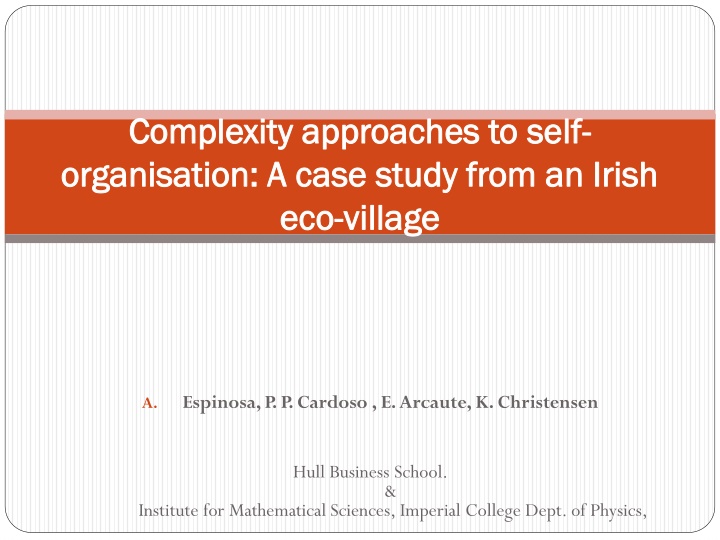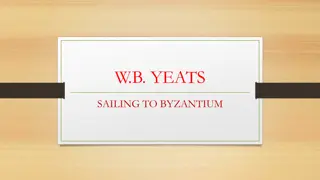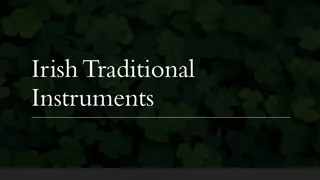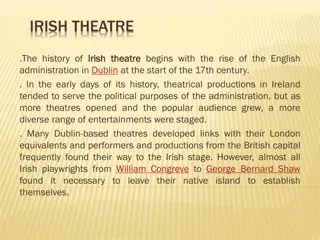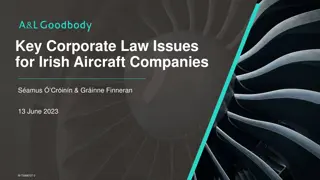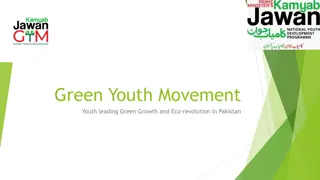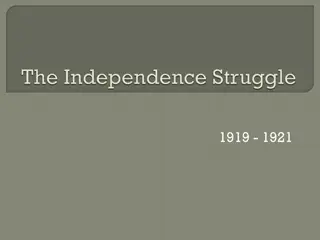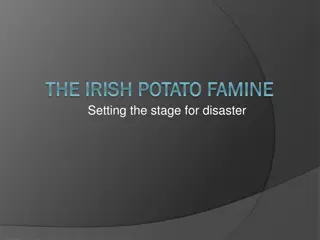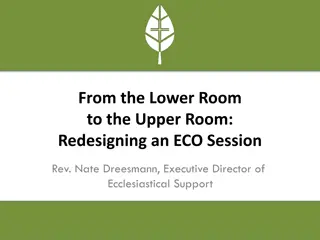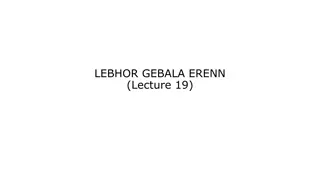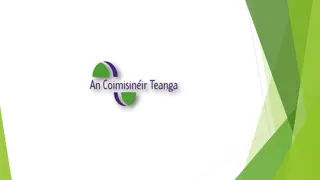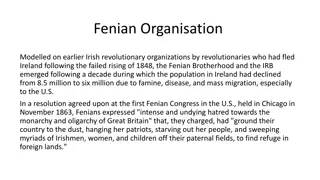Complexity Approaches to Self-Organization: A Case Study from an Irish Eco-Village
This case study explores complexity approaches to self-organization in an Irish eco-village, using methodologies such as Viable Systems Model (VSM) Analysis and Social Network Analysis (SNA). The research delves into the background, development, and tools for regeneration within the community, emphasizing the need for decentralized management and incorporating principles of complexity management. Various visualization and planning toolsets are employed to facilitate self-reference and adaptive actions within the community.
Download Presentation

Please find below an Image/Link to download the presentation.
The content on the website is provided AS IS for your information and personal use only. It may not be sold, licensed, or shared on other websites without obtaining consent from the author.If you encounter any issues during the download, it is possible that the publisher has removed the file from their server.
You are allowed to download the files provided on this website for personal or commercial use, subject to the condition that they are used lawfully. All files are the property of their respective owners.
The content on the website is provided AS IS for your information and personal use only. It may not be sold, licensed, or shared on other websites without obtaining consent from the author.
E N D
Presentation Transcript
Complexity approaches to self Complexity approaches to self- - organisation: A case study from an Irish organisation: A case study from an Irish eco eco- -village village Espinosa, P. P. Cardoso , E. Arcaute, K. Christensen A. Hull Business School. & Institute for Mathematical Sciences, Imperial College Dept. of Physics,
Content Research Background Research approach and development The eco-village VSM Analysis SNA Analysis Findings Conclusions
Research Background EPSRC funded UK research network Emergence and Complexity Defying the rules: How self-regulatory social systems work Action research The case study undertaken in the context of a consultancy. Viable Systems Model to deal with organisational issues in an Irish eco-village
Research approach and development Regeneration context Regeneration context From 1950 to 2010 Trends: decentralization and empowerment of local communities Tool have evolved, incorporating principles of complexity management. Because administrated by delivery (relief) agencies, it still need more work in the transfer of management to the local communities Independent Initiatives TOOLS for regeneration TOOLS for regeneration TOOL PQASSO Visible Communities Local Multiplier Origen Voluntary sector Community associations New Economy Foundation British Standards Learning Futures Ltd & CIbit Research Project SIGMA KALIF MOOBELA
Research approach and development The SO The SO in communities in communities TOOLS for SO TOOLS for SO Tool Applicatio n Consensus SD-SMTW Consensus Drive teams Planning Planning Planning C-practice Mechanis m Aggregation Flows Aggregation Flows Tagging Tagging Flows Flows Different approaches varying from Games Theory to Complex Adaptive Systems Ostrom AGIL Sociocracy DSIT-Latane OST W-cafe T-Sintegrity KALIF To be used for different purposes and in different stages of the design-plan- implement cycle
Visualization and Planning Toolset Reflective Loop Visualization Loop Planning Loop 1-Creation of a consolidated narrative 2-VSM + SNA in context (Narrative) 3-Evaluation of the Self-reference 4-Socialization & Critical review (New beginning?) 1-VSM Workshops 2-VSM Feedback 3-SNA 4-Narratives & Story telling 1-VSM Appropriation 2-SNA Interpretation 3-SNA in context (narratives) 4-Adaptation. Self-reference in action
The Village Established in 1999 as a charity aimed to build a sustainable community independent rural regeneration program. Designed as a non-hierarchical organization making decisions using consensual mechanisms. Three diferent stages of development are noticeable in the evolution of the organization, each one define by a particular set of critical events. PRE MID POST
SNA Analysis Note that the values of weakly components, reciprocity, and the in and out degree improved from PRE to POST. The intervention helped the community to develop a more cohesive community, with higher connectivity and reciprocity, and with a more efficient communication network.
VSM Analysis p=connectance The connectance gives the fraction of links present from a maximum possible, according to the current number of nodes (Newman, 2010). In this case we give the percentage of the value of the connectance relative to the maximum density of links that one could get taking into account the number of individuals that were interviewed. Note the variation in the values of S3 and S4, the most beneficed from the intervention
Findings & Conclusions Findings Findings Choices made in meta-systemic management affected positively the general connectivity The study reconfirms the importance of shared mental models in the process of self organisation Distribution of crucial information is a key issue in SO SNA provide insightful evidence and alternative analytical lens not used in traditional VSM applications. Conclusions Conclusions VSM = framework and templates to classify, organise and contextualise information about roles, tasks, resources, rules of the game and interactions SNA offers quantitative routines to describe in detail the connections, sensible points (nodes) and the dynamics of interactions among the different constitutive elements identified with the VSM distinctions. Empirical evidence of the importance of Shared mental models (VSM +SNA) VSM+SNA as analytical tools to study co-evolving and adaptive management.
References Anderson, P. (1999), Complexity theory and organization science . Organization Science, Vol. 10, No. 3, pp. 216-232. Arcaute, E., Christensen, K., Sendova-Franks, A, Dahl, T. and Espinosa, A. (2009). Division of labour in ant colonies in terms of attractive fields . Ecological Complexity. Vol 6 No 4, pp. 396-402. Axelrod R. (1997). The complexity of cooperation, agent based models of competition and cooperation, Princeton University Press, Princeton. Bar-Yam, Y. (2000). "Complexity rising, From human beings to human civilization: a complexity profile". Available (Nov 2010) http://necsi.org/Civilization.html. Accessed Nov 12th, 2010. Beer, S. (1979). Heart of the Enterprise, John Wiley & Sons, Chichester. Beer, S. (1981). Brain of the Firm, John Wiley and Sons, Chichester, UK Beer, S. (1985). Diagnosing the System for Organisation, John Wiley & Sons, Chichester. Beer, S. (1994). Beyond Dispute: The invention of Team Syntegrity, John Wiley & Sons, Chichester. Brown, J. & Isaacs, D. (1994). Merging the best of two words. The core processes of organizations as communities . In: Senge et al, (1994). The Fifth DisciplineFieldbook: Strategies and Tools Building a Learning Organization.[Online]. Available: http://www.theworldcafe.com/articles/mergingbest.pdf [Accessed November 12th 2010]. Browning, L.D., Beyer, J.M. and Shetler, J.C. (1995). Building cooperation in a competitive industry , The Academy of Management Journal, Vol 38, No 1, pp. 113-151. Romme, A. G. L. (1995), The sociocratic model of organizing. Strategic Change, 4: 209 215. Cardoso, P. (2009). Facilitation self-organisation in non-hierarchical communities: A Methodology for regeneration programs . In: Clarckson, G. (Ed). Business and Organizational Survival and Sustainability. The Northern Leadership Academy Fellows 2009. Leeds University Business School. Cardoso, P.P. (2011, forthcoming) - Facilitating self-organisation in non-hierarchical communities. A methodology for regeneration programs. PhD Thesis. Hull University Business School. Submitted Nov 2010. Espejo, R., Schuhmann, W., Schwaninger M. and Billelo, U. (1996). Organisational Transformation and Learning, John Wiley & Sons, London. Espinosa, A, Walker, J. (2011, in press). Complexity and Sudtainability, Theory and Practice. Invited Research Monograph. Jensen, H. (Ed). Book Series in Complexity. Imperial College Press. Espinosa, A, Porter, T. (2011, forthcoming). Sustainability, Complexity and Learning: Insights from Complex Systems Approaches . Invited paper. The Learning Organisation. Special Issue. January 2011. Kelleher, M., Van Heijst, G.,Kruizinga, E., Haldane, A. & Van Der Wal, C. (2001). KALIF: To Share is to Multiply. CIBIT: Utrecht. The Netherlands. Kilduff, M. and Tsai, W. (2003). Social Networks and Organisations. London: Sage.
References Latane, B. (1981). The psychology of social impact . American psicologist. Vol 36. Pp. 343-356. Latane, B. and Bourgeois, M. (1996). Experimental Evidence for Dynamic Social Impact: The Emergence of Subcultures in Electronic Groups . Journal of Communication. 46 (4):35-47. Sacks, J. (2002). The Money Trail. [Online]. London, New Economy Foundation. Available: http://www.neweconomics.org/publications?keys=LM3&tid=All [Accessed 10 Novemeber 2010] Moobela, C. (2004). Exploring the potential of complexity theory in urban regeneration processes. Phd Thesis. Sheffield Hallam, Sheffield Hallam Universisity McMillan, E. (2004). Complexity, Organisations and Change. Abingdon, Oxon: Routledge. Mitleton-Kelly, E. (2003). Complex Systems and Evolutionary Perspectives on Organisations. The Application of Complexity Theory to Organisations. London: Pergamon. Newman, M.E.J. (2010). Networks: An Introduction. Oxford University Press. Ostrom, E. (1995). Self-Organisation and Social Capital . Industrial and Corporate Change. Vol 4. No. 1, pp. 131-159. Owen, H. (n.d.). Open Space for Emerging Order. [Online]. Available: http://www.openspaceworld.com/brief_history.htm [Accessed 10 November 2010] Paucar-Caceres, A., Espinosa, A. (2010), Management Science Methodologies In Environmental Management And Sustainability: Discourses And Applications , Journal Of The Operational Research Society. Earlyview available online at [http://www.palgrave-journals.com/jors/journal/vaop/ncurrent/full/jors2010110a.html] PQASSO (2004). PQASSO. IN SERVICES, C. E. Ed., Jackie Scutt, Scottish Social Enterprise Academy (SFEDI Endorsement). [Online]. New Econmic Foundation. Available:http://www.proveandimprove.org/new/tools/PQASSO.php#Section5 [Accessed 10 November 2010]. The SIGMA Project (1999). The Sigma Project. IN PROJECT, T. S. [Online]. Ed., Department of trade and industry, UK. Available: http://www.projectsigma.co.uk/ [Accessed 10 November 2010]. Richardson, K. (2008). Managing complex organisations: Complexity thinking and the science and art of management , Emergence, Vol. 10, No. 2, pp. 13-26.
